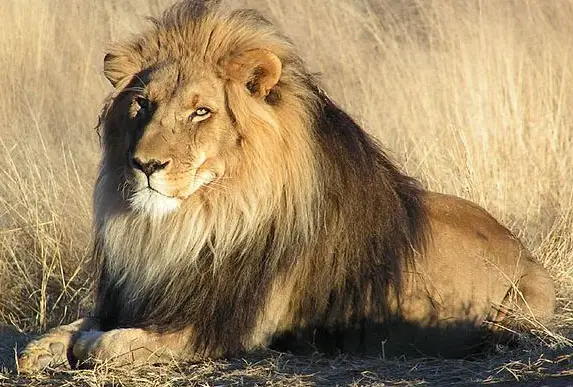|
Lion Cartridges By Chuck Hawks  The lion, Panthera leo, along with the tiger, is the largest of the big cats in the Panthera family, which also includes the leopard and jaguar. Although lions once inhabited much of Africa and Eurasia, today they are largely confined to areas of sub-Saharan Africa. (There is a remnant population of Asian lions in India, which are fully protected.) Lion numbers have been reduced by an estimated 50% since 1980, primarily due to the human population explosion in Africa, warfare, reduction of large prey species and (most of all) loss of habitat. For that reason it has taken me a long time to decide to write this article. All of the Panthera family cats face similar habitat reduction and their survival has become increasingly threatened throughout my lifetime. I would not shoot a big cat today unless it was necessary to save a human life (especially mine!) and I don't want to be in the position of promoting the hunting of big cats. There are plenty of herbivores to hunt, so I advocate voluntarily giving the big cats a break. My feeling is their lives are difficult enough in the 21st Century without my interference. On the other hand, lion cartridges are a topic of interest to hunters everywhere, even those who will never set foot in Africa and have no intention of actually hunting the big cats. Hence, my decision to publish this article for the enjoyment of Guns and Shooting Online readers. From the hunter's perspective, all members of the Panthera family are considered to be CXP4 (dangerous) game and the African lion is probably the world's most dangerous beast that can still be legally hunted. Lions are highly intelligent animals and, unlike the other Panthera, they are social cats that typically live in groups (prides) and hunt cooperatively. A pride of lions can employ extremely sophisticated and adaptive hunting strategies and exhibit complex behaviors, leaving no doubt about their superior intelligence. The average mature male lion is estimated to weigh around 330 pounds, while very large males may weigh 500 pounds. Adult lionesses are smaller than the males, weighing between 260-400 pounds. Lions are not typically man eaters, but they are smart enough to hold a grudge if pestered or injured by humans. If they become too infirm to catch their usual prey they may turn to killing people out of necessity. Historically, most African native peoples and the local lion population learned to coexist as apex predators without undue friction. Lions are large, immensely strong and can charge with startling speed, so a powerful rifle (repeater or double-barrel) and a low magnification scope with a large field of view is the ticket for most lion hunting, or for protection from lions in the field. Across most of sub-Saharan Africa, the 9.3x62mm Mauser and/or .375 H&H Magnum are the mandated minimum cartridges for lion hunting. These and similar medium bore calibers are excellent choices for the purpose and give the hunter a reasonable safety margin in terms of killing power. In addition, the rifles for these calibers need not be as heavy as those for the big bore safari rifles, allowing them to handle faster when the chips are down. Lions are smaller than the North American grizzly bear and under most circumstances "all-around" cartridges on the order of the .30-06 are quite capable of killing even the largest undisturbed lion. For example, Eleanor O'Connor (gun writer Jack O'Connor's wife and a very experienced huntress in her own right) took the family's best ever lion trophy with a .30-06. However, while the all-around cartridges may be adequate under most circumstances, they might not stop or turn a charge. Use bullets designed to expand rapidly on 300-500 pound animals while still offering adequate penetration. Hornady's InterLock, Nosler's Partition and Remington's Core-Lokt would be examples of widely distributed, suitable bullets. Perhaps the optimum lion bullet, in the calibers for which it is available, is the A-Square Lion Load. As the name implies, this bullet was developed specifically for lion hunting. Bullets with sectional densities of at least .250 for medium and big bore cartridges (.33 caliber and larger) would seem to be reasonable. Common bullet weights meeting or exceeding that standard would be 225 grain in .33-.35 caliber, 250 grain in 9.3mm-.375 caliber, 300 grain in .405 caliber and 400 grain in .416-.458 caliber. Again, these are typical minimum bullet weights; heavier for caliber bullets are even more of a good thing. Here are examples (this list is not intended to be all-inclusive) of some potential lion cartridges (where legal): .338-06, .338 Win. Magnum, .340 Weatherby Magnum, .35 Whelen, .350 Rem. Magnum, .358 Norma Magnum, 9.3x62mm, 9.3x64mm, 9.3x74R, .405 Winchester, .450/400 NE, .416 Rem. Magnum, .416 Rigby and .458 Win. Magnum. Cartridges more powerful than the .416 and .458 Magnums could certainly be used to dispatch any lion, but their extreme recoil and ponderous weight mitigate against their use, unless nothing more reasonable is available. Like all of the cartridge recommendations in my series on big game animals, the cartridge recommendations above assume that the hunter selects an adequate bullet and gets it into a vital spot. As in all hunting, but particularly when lion hunting, correct bullet placement is far more important than sheer power. Make absolutely sure that your first shot will be immediately fatal. If you have any doubts, don't shoot and live to hunt another day. |